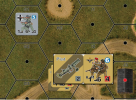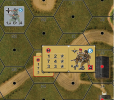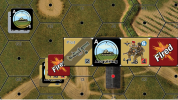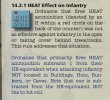Confirming - the “H” on the Piat means that the Piat can affect troops in the open with a FP of 2? (3 on the back of the counter - 1=2)
If not, please enlighten me on the rules regarding SW ordinance and infantry.
Usually an attack with H weapons against infantry in the open is resolved like this:
1 - Activate unit with the H SW and decide to fire at an enemy infantry;
2 - The H sw attacks are resolved after or before any other attack from the same unit possessing the H SW but never at the same time ( in other words the PIAT fires as if its another unit and you don't sum your HE with the unit firepower firing it ).
A British 1-6-4 with a PIAT can fire his 1 FP and THEN the PIAT as two separate attacks.
3 - Flip the PIAT counter and see the range you want to fire on.
4 - After you found your range ( that must be equal or lower to the printed number on the top of the table ) go down one square and look at the second number, that is the TO HIT number.
5 - Roll 2 Dice ( D6 ). Add one to your die roll for each degrading hex in LoS your shot pass trought, add the target Terrain Modifier and any other modifier the Ordnance Fire Table tells you ( OFT ).
6 - If the result, after all modifiers applied above is less or equal of the TO HIT number printed on your PIAT counter then the raget is hit and you use the HE equivalent printed on the front of the PIAT counter as the damage.
7 - The attacker now roll a D6.
8 - Add that D6 result with the HE equivalent printed on the front of the PIAT counter MINUS ONE if the target is NOT in a building, huts, bunker or cave. For example the PIAT is HE 2 it becomes HE 1.
9 - The target roll 1 D6 and nothing more.
10 - Substract the Defender's total of point 9 from the attacker's total of point 8.
11 - Check the corresponding table to see if the unit survived or not. You know the drill, if attacker's total-defender's total >0 add that plus roll 1 D6, sum them and check the table to see if its shaken, reduced, etc.
12 - Repeat from point 9 if there are multiple infantry units in the hex.
13 - If the units survives place a -1 acquisition marker on the units and an acquiring of the firing unit with the PIAT. ( not 100% sure about this point ).
14 - PIAT sucks.




